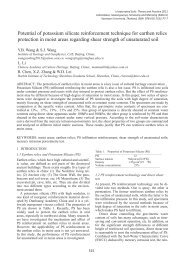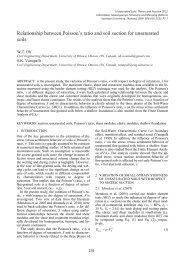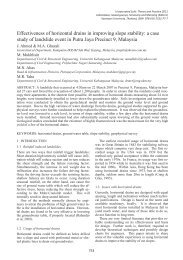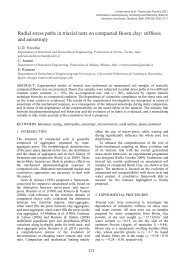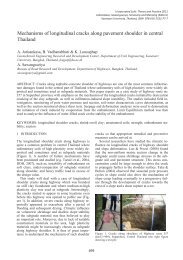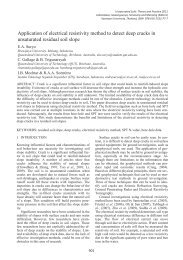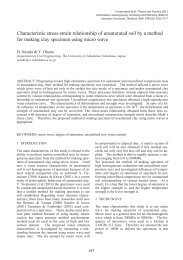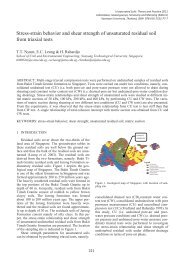Obtaining unsaturated soil properties for high volume change oil ...
Obtaining unsaturated soil properties for high volume change oil ...
Obtaining unsaturated soil properties for high volume change oil ...
- No tags were found...
You also want an ePaper? Increase the reach of your titles
YUMPU automatically turns print PDFs into web optimized ePapers that Google loves.
2 ROLE OF THE SOIL-WATERCHARACTERISTIC CURVE, SWCCThe SWCC shows the relationship between theamount of water in a <strong>s<strong>oil</strong></strong> and various applied <strong>s<strong>oil</strong></strong>suctions (Fredlund and Rahardjo, 1993). There aretwo primary reference points on the SWCC; namely,the air-entry value and the residual suction. Theapparent air-entry value <strong>for</strong> a <strong>s<strong>oil</strong></strong> is dependent onhow the amount of water in the <strong>s<strong>oil</strong></strong> is quantified.When a <strong>s<strong>oil</strong></strong> undergoes <strong>volume</strong> <strong>change</strong> as <strong>s<strong>oil</strong></strong>suction is increased, the air-entry value appears tooccur at different values. The differing air-entryvalues are related to how the amount of water in the<strong>s<strong>oil</strong></strong> is defined. Each variable to designate theamount of water in the <strong>s<strong>oil</strong></strong> has significance but it isimportant that the correct interpretations be appliedat various stages of the analysis (Fredlund, 2002).The variables used to quantify the amount ofwater in the <strong>s<strong>oil</strong></strong> are:i) gravimetric water content, w;ii) <strong>volume</strong>tric water content, θ; with theinstantaneous total <strong>volume</strong> used in calculating<strong>volume</strong>tric water content;iii) <strong>volume</strong>tric water content, θ, with the <strong>volume</strong> ofwater, V w , referenced to original total <strong>volume</strong> ofthe specimen, V o , (i.e., V w / V o ); andiv) degree of saturation, S.Each of the above designation <strong>for</strong> the amount ofwater in the <strong>s<strong>oil</strong></strong> can be used to plot a <strong>s<strong>oil</strong></strong>-watercharacteristic curve. Each of the SWCCs wouldprovide similar in<strong>for</strong>mation to the geotechnicalengineer provided the <strong>s<strong>oil</strong></strong> does not undergo <strong>volume</strong><strong>change</strong> as <strong>s<strong>oil</strong></strong> suction is increased. However, whenthe <strong>s<strong>oil</strong></strong> undergoes <strong>volume</strong> <strong>change</strong>, as is the caseunder consideration, then the geotechnical engineermust be able to plot each of the SWCCs and use theappropriate curves in the proper manner <strong>for</strong>evaluating <strong>unsaturated</strong> <strong>s<strong>oil</strong></strong> property functions to beused in per<strong>for</strong>ming numerical simulations ofphysical processes.Gravimetric water content is the most basicmeasurement of the amount of water in a <strong>s<strong>oil</strong></strong>because it requires only the measurement of mass.Volumetric water content, θ, has commonly beenused in agriculture-related disciplines and is definedas the amount of water in the <strong>s<strong>oil</strong></strong> referenced to theinstantaneous total <strong>volume</strong> of the <strong>s<strong>oil</strong></strong> specimen. Thetotal <strong>volume</strong> of the <strong>s<strong>oil</strong></strong> specimen must be knownwhen computing the <strong>volume</strong>tric water content in thismanner. There<strong>for</strong>e, it is necessary to know the total<strong>volume</strong> of the <strong>s<strong>oil</strong></strong> specimen corresponding toequilibrium <strong>s<strong>oil</strong></strong> suction conditions. When modelingwater seepage through a <strong>s<strong>oil</strong></strong>, it is the <strong>change</strong> in<strong>volume</strong>tric water content that defines the <strong>change</strong> inwater storage in the <strong>s<strong>oil</strong></strong> as suction <strong>change</strong>s.However, there are two possible ways to compute<strong>volume</strong>tric water content. If the overall <strong>volume</strong> ofthe <strong>s<strong>oil</strong></strong> <strong>change</strong>s by a small amount during theincrease in <strong>s<strong>oil</strong></strong> suction, then either designation of<strong>volume</strong>tric water content can be used. However, ifthe <strong>volume</strong> <strong>change</strong>s are substantial, then theinstantaneous total <strong>volume</strong> should be used <strong>for</strong> thecalculation of the water storage function.The degree of saturation, S, references the<strong>volume</strong> of water in the <strong>s<strong>oil</strong></strong> to the instantaneous<strong>volume</strong> of voids and there<strong>for</strong>e also requires the total<strong>volume</strong> of the specimen. When a <strong>s<strong>oil</strong></strong> undergoes<strong>volume</strong> <strong>change</strong> as <strong>s<strong>oil</strong></strong> suction increases, then the airentryvalue and residual conditions need to beevaluated from the plot of degree of saturationversus <strong>s<strong>oil</strong></strong> suction. In addition, it is the degree ofsaturation versus <strong>s<strong>oil</strong></strong> suction plot that must be usedduring the integration process to calculate thepermeability function. The permeability functionmay also need to be computed in a different mannerto accommodate <strong>change</strong>s in void ratio prior toreaching the air-entry value of the <strong>s<strong>oil</strong></strong>.It is important to note that the <strong>unsaturated</strong> <strong>s<strong>oil</strong></strong>property functions need to be computed in distinctlydifferent manners when the <strong>s<strong>oil</strong></strong> undergoessubstantial <strong>volume</strong> <strong>change</strong> as <strong>s<strong>oil</strong></strong> suction increases.It is the instantaneous <strong>volume</strong>tric water contentdesignation that must be used to compute waterstorage and the degree of saturation designation thatmust be used to define the air-entry value of the <strong>s<strong>oil</strong></strong>.The degree of saturation designation plays the majorrole involved in estimating the <strong>unsaturated</strong> hydraulicconductivity function of the <strong>s<strong>oil</strong></strong>.The <strong>s<strong>oil</strong></strong>s of primary concern in this paper are the<strong>high</strong> water content tailings that are a by-productfrom Oil Sands extraction. These materials may startwith a natural water content that is well above theliquid limit of the material and undergo a large<strong>volume</strong> <strong>change</strong> upon drying.The difficulties associated with the testing of<strong>s<strong>oil</strong></strong>s that undergo large <strong>volume</strong> <strong>change</strong>s withincreasing <strong>s<strong>oil</strong></strong> suctions are not a recent discovery.Fredlund (1964) showed that shrinkage curvemeasurements needed to be used in conjunction witha conventional measurement of the SWCC in orderto properly interpret the <strong>unsaturated</strong> <strong>s<strong>oil</strong></strong> behaviourof <strong>high</strong> <strong>volume</strong> <strong>change</strong> <strong>s<strong>oil</strong></strong>s. Fredlund (loc. cit.)per<strong>for</strong>med a series of tests on <strong>high</strong>ly plastic Reginaclay that had a liquid limit of 75, a plastic limit of25, and had 50% clay size particles.3 SHRINKAGE LIMIT AND THE SHRINKAGECURVEThe shrinkage limit of a <strong>s<strong>oil</strong></strong> has been one of theclassification <strong>properties</strong> since the inception of <strong>s<strong>oil</strong></strong>mechanics (ASTM D427). Mercury immersion wasoriginally used <strong>for</strong> the measurement of the <strong>volume</strong>416



